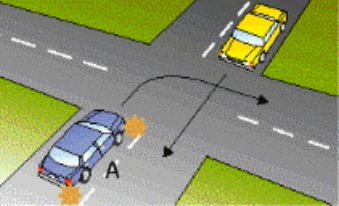
Explanation:
Whenever you make a turn, you must yield to oncoming traffic.
Explanation:
The camera will not activate if your car is already in the junction when the lights turn red.
Explanation:
When turning at an unmarked intersection, give way to vehicles approaching from the right and vehicles approaching straight ahead.
Explanation:
Because the lights have only just turned yellow, you should have enough time to get through the crossing before the traffic lights turn green.
Explanation:
A vehicle turning right must yield to a vehicle turning left when two cars are facing each other at an intersection with the same signs or signals or no signs or signals (as in this instance).
Please select 2 correct answers
Explanation:
A T-intersection is created when two roads come together to form a T. Drivers on the top and bottom of the T must yield to each other. Drivers on the top of the T must yield to a car turning right into the bottom of the T, however drivers on the bottom of the T are exempt from this requirement.
Explanation:
To turn into a driveway or side road or to accelerate to the same speed as traffic when leaving a driveway or side road, you can travel up to 50 meters.
Explanation:
This allows other vehicles to pass on your left.
Explanation:
You must yield to all oncoming traffic when leaving a driveway, even a public one like one at a store or hospital. Similar to how the T-intersection rule operates, so does this rule.
Explanation:
At the Give Way sign, the red car is required to stop and yield to the blue vehicle.
Explanation:
Because traffic may appear, you must be prepared to stop if necessary.
Explanation:
If you're travelling straight through an unmarked intersection, give way to the right.
Explanation:
If there is already a pedestrian in the road, you must yield.
Explanation:
The red car must come to a complete stop at the stop sign and yield to the blue car.
Explanation:
As you approach the roundabout, begin signaling and halt only when you have completed your turn.
Explanation:
Both cars can simultaneously pass in front of one another if they are turning right.
Explanation:
Straight through the intersection is the red car. Because the blue car is turning into its path, it must make room.
Explanation:
The red car must yield to the blue car because the give way laws apply and both vehicles have a green signal.
Explanation:
If there are emergency vehicles approaching the intersection, if the traffic lights turn red just before you arrive, if there are pedestrians present, or if you observe another vehicle approaching that you must yield to, you may need to stop.
Explanation:
Always remember to take a second look in case you missed something the first time around. Regardless of whether you believe the intersection will be clear, you should always look.